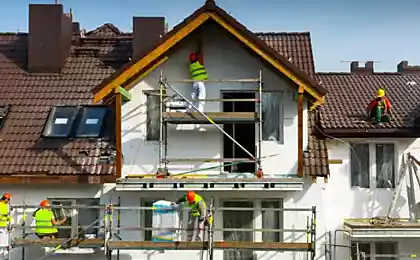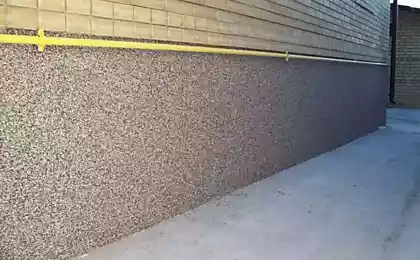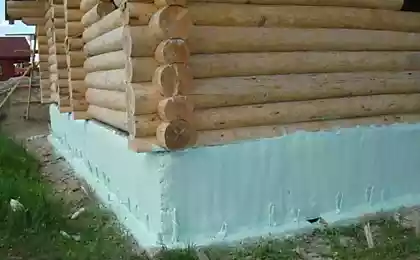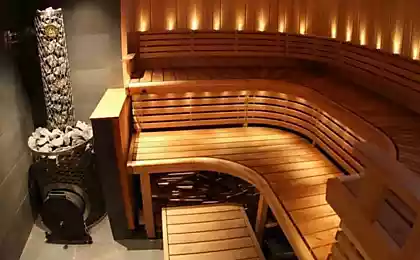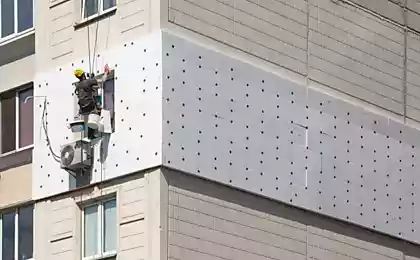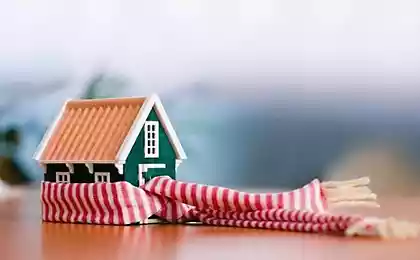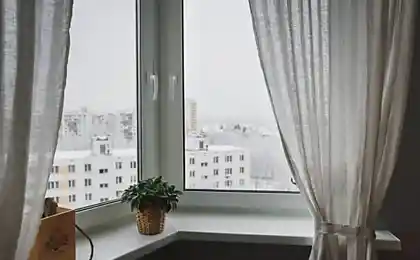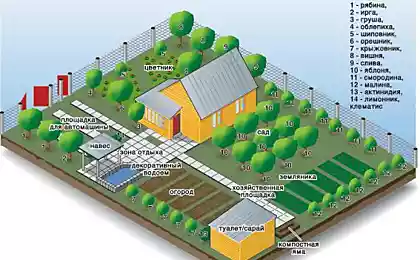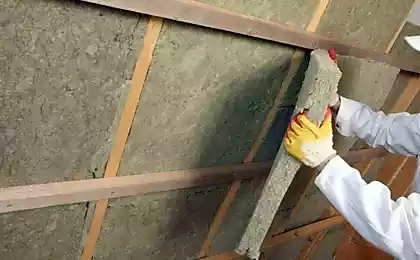1515
How to insulate the house, quickly, simply and with a minimum budget
How to insulate a house today, has written many articles and even books. Any hardware store will tell you that you need to buy, and any of the firms or teams specializing in the construction and finish offer modern technology of warming a country house or Villa. Only here everything is expensive... But what if your budget is limited, but freeze in the country do not want? Insulate using available materials, experience and ingenuity.
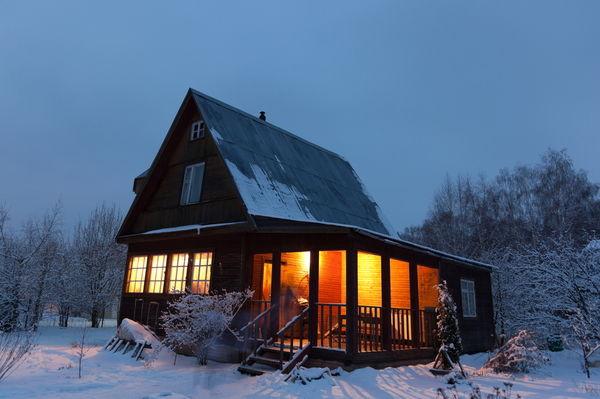
The street was cold, so today we will discuss how the minimum cost (money, time and effort) significantly reduce the loss of heat in a wooden house. Highlight: wood! For buildings of other materials and approaches may be different, although many General principles remain.
Ways in which heat leaves our house
Can be installed in any dwelling, most modern heating system, but it will be inefficient, if the heat flows away to the street. Insulation is, in fact, the elimination of such leaks. So, before you go to work, you have to understand where to look for the problem.
Numbers are called specialists, can (depending on the source) vary slightly, but generally consists of approximately such picture:
on Windows and doors account for 25% (some up to 30) of heat loss;
10-15% disappears through the ceiling;
a minimum of 15% goes on the floor;
35% (and maybe up to 50!) we lose heat through the walls
Wish it was warm, — it is necessary to consistently perform all the vulnerable areas of your home to identify leaks and to get rid of them. Easy and simple, right? No way... If you approach the issue correctly, "science", using modern materials and technologies in the home will certainly be a lot warmer and cozier, but... the Amount you have to pay will amount to tens, and even hundreds thousand roubles. This time we'll go the other way)) Remember old-fashioned methods and will try to keep within a very modest budget.
Windows
Those who have in the country installed plastic Windows with double glazing, this section can safely ignore — it will be about wood Windows. Perhaps the old. Maybe even require replacement. Such are many country houses. However, even new wood Windows (tested!) from the cold can not protect too well, and this is their unconditional negative. What to do?

You can replace the glass thicker, and even on the Windows. This experience is one of our authors, and the whole process is described in the material New old Windows or double glazing in old frames. You can do shutters on the Windows — they protect from wind and reduce heat loss (of course, it will have to keep the shutters closed). But both these methods are also quite time-consuming, require time and financial costs.
We use the old methods — without changing anything, will insulate what is inside:
with a special sealant or putty frame reinforcing the joints with glass window frame. If necessary, change (put instead of the lost) bead;
if the glass is cracked, it would be better, of course, to replace them; if this is not possible, will help ordinary stationery tape pasted over cracks directly on the glass (note: if it is wet or cold, the tape will not stick);
if the outside temperature has not fallen below zero, we glue around the perimeter of all frames insulation — PVC or rubber (if the glue at low temperatures, adhesive insulation to stick on the frames will not or will, but very poorly);
caulk all the cracks in the frames, using cotton wool (from an old mattress, for example), scraps of foam or wadding, newsprint, and similar materials on hand;
seal all of this on top of paper strips (bought with an adhesive layer or homemade);
if frame a double bottom between them can be laid wool or any other insulation, making it a tidy cushion.
If done carefully and accurately, and the frame is not too old, this will be enough. If, despite all efforts, the window is still perceptible blowing, or just reluctant to Tinker with practicianer and sealing, you can use a very simple way, giving, however, a great effect.
You will need a piece of plastic film (slightly larger than the window) and upholstery staple gun with staples (for lack of a stapler, a hammer, a bead or narrow rake and small nails). Fasten the tape around the perimeter of the window (between frames or from the premises — depending on frame design and their own desires). And that's all! If you use a stapler, one window will take about 15 minutes (who has a skill — less). The film serves as a barrier to cold air and drafts and allows heat to sail us through the window.
The disadvantage of this method: to open the window to ventilate the room, you will not be able. This is to think ahead and not to "wall up" tightly all Windows — ventilation needed even in the winter. Well, for those who like to look out the window, this option is not suitable: through the film are visible, only vague outlines of the surrounding landscape. But here it is necessary to choose what is more important...
Door
Warm makes sense the outer door and the interior, especially leading into the cold utility room or hallway. Our main goal is to eliminate the gap that sooner or later, are formed between the door and the frame. And it can be dealt with fairly simply:
to put the seals (this option is ideal if the gap is small);
if blowing under the door — to consolidate her bottom with special sealing brush (to buy the finished product or make your own from thick rubber or other scrap materials)
hang a thick curtain.
If you want a quick and effective way, it is the last option turns out to be the most successful. The main thing — that the material of the blinds were really tight (summer chintz curtains against the cold will not save us). This element of the insulation can become a bright and original part of the decor of the room. Well, if the design issues you worry a little, you can even use old wool or cotton blanket.
Here, perhaps, someone will contemptuously wrinkle nose: "EW old-fashioned!" — well, because sometimes it is these old-fashioned things work better than the modern "bells and whistles". Here is an example from practice. In the new house I have a large (approximately 1.5 x 2 m) hole in the wall that separates the warm living room from the cool hallway. Door or some other fundamental constructions in the doorway while my plans are not included, but the warmness as it is necessary... there were old plush curtains just the right size. I have many kept saying, "what's the use? All the heat goes into the gap between the wall and the ceiling, and the curtains do not keep". But since none of the advisers have not offered anything better, all last winter this curtain safely "worked". The temperature difference in rooms that she shared, it could reach up to 3-4 degrees. And in the rural country home I have the winter front door in the warm (living) part has always zaveshivali quilt — very simple, but effective.
The ceiling
I have to say a few words about the insulation of the roof. Today it is considered almost mandatory. Meanwhile, take a look at the old village houses — lot of you out there will find insulated roofs? And in the heated house in the dead of winter warm. Why?
The roof insulation makes sense in that case, if the second floor (attic) is a residential. If it's just the attic, the focus is on thermal insulation of ceiling (beams). Even those who are familiar with physics is bad, surely you know: warm air is lighter than cold and therefore rises. And leaks to the atmosphere through the cracks in the ceiling, if any. The ceiling, not allowing heat to escape from the house, one of the most important items is a good insulation.
Perhaps the most economical and easiest option is foam. But from my point of view, its benefits and dignity on and exhausted. It will fit, if you insulate you need to quickly and quite inexpensive (though to save on the quality of the material and to choose a foam with a minimum density I wouldn't advise it; best PSB-s 25).
I will not go into detail — this thread is safely possible to devote separate article. I can only say: if you want better insulation, buy polystyrene plates with milled edge — they snap together lap. Attempts to fit tight a regular smooth edge plates are doomed: they still remain the gap that the shrinkage of the wooden supporting structures can also increase. But through these cracks, of course, leaves precious heat.
Is there an alternative? Within a limited budget — I'm afraid not (if there is a builders-specialists, who will correct me, I'll be extremely grateful: for me, this issue is of great practical value :)) an Earthen fill that was used in old rustic homes, is now almost never used.
Sometimes you can find recommendations to close the ceiling inside the heat insulation material is laid (options: izokom, energoflex and the like). It really is fast, simple and relatively inexpensive (depending on material brand and its manufacturer). But (subjective opinion of a layman, do not judge strictly)) I still think that this is not the best option for the dwelling... Who tried — let's discuss in the comments, share your experiences and impressions. I especially want to find out how such warming can affect the humidity level in the room (not formed if the condensate is on this ceiling?)
Floor
Cold floor — the trouble is the majority of wooden houses. Today there are many ways a radical solution to this problem, but we today, as you remember, we are talking about the easiest and cheapest options. Therefore, the subject of Underfloor heating, for example, will not be considered. And what then can be done?
The first is to insulate the dwelling perimeter: no matter how good I was fitting the floor and picked up the plinth, the gap between the floor and the wall exist. If the basement is not insulated, from the bottom through these gaps will penetrate the cold air. And here again, the heat insulation material is laid to help us: the strip of this material (foil layer inside) fixed by means of furniture staples (or small nails if the staples are not) so that one edge went to the wall, and another lay on the floor. Quickly, just -- and the room becomes noticeably warmer. Check it out!
Use the heat insulation material is laid and solid floor insulation (there is already someone how does someone secures it from the basement that someone used instead of a substrate for a floor covering, but the reviews I have heard only positive from those from others).
The second — floor surface. Homespun rugs in country houses, in addition to decorative function, are purely practical: it is additional insulation. So, if you have rugs, carpets, walkways and mats — lay them on the floor, and you will be warm))
Wall
As we remember, through the walls out of the house the maximum amount of heat. And here I have some bad news: to insulate the wooden walls quickly, simply, and cheap will not work. If we want the house lived a long time, you need to make high-quality external insulation. Improvised tools and materials, there is not enough, alas.

In addition, very much depends on the material and construction technology. Timber or timber? How thick (diameter)? The ordinary beam, glued profiled? A simple log or bale? And so on... every case has its own nuances. Moreover, there are issues that should be envisaged at the stage of design is then to eliminate the problem would be complicated and expensive.
Source: www.7dach.ru

The street was cold, so today we will discuss how the minimum cost (money, time and effort) significantly reduce the loss of heat in a wooden house. Highlight: wood! For buildings of other materials and approaches may be different, although many General principles remain.
Ways in which heat leaves our house
Can be installed in any dwelling, most modern heating system, but it will be inefficient, if the heat flows away to the street. Insulation is, in fact, the elimination of such leaks. So, before you go to work, you have to understand where to look for the problem.
Numbers are called specialists, can (depending on the source) vary slightly, but generally consists of approximately such picture:
on Windows and doors account for 25% (some up to 30) of heat loss;
10-15% disappears through the ceiling;
a minimum of 15% goes on the floor;
35% (and maybe up to 50!) we lose heat through the walls
Wish it was warm, — it is necessary to consistently perform all the vulnerable areas of your home to identify leaks and to get rid of them. Easy and simple, right? No way... If you approach the issue correctly, "science", using modern materials and technologies in the home will certainly be a lot warmer and cozier, but... the Amount you have to pay will amount to tens, and even hundreds thousand roubles. This time we'll go the other way)) Remember old-fashioned methods and will try to keep within a very modest budget.
Windows
Those who have in the country installed plastic Windows with double glazing, this section can safely ignore — it will be about wood Windows. Perhaps the old. Maybe even require replacement. Such are many country houses. However, even new wood Windows (tested!) from the cold can not protect too well, and this is their unconditional negative. What to do?

You can replace the glass thicker, and even on the Windows. This experience is one of our authors, and the whole process is described in the material New old Windows or double glazing in old frames. You can do shutters on the Windows — they protect from wind and reduce heat loss (of course, it will have to keep the shutters closed). But both these methods are also quite time-consuming, require time and financial costs.
We use the old methods — without changing anything, will insulate what is inside:
with a special sealant or putty frame reinforcing the joints with glass window frame. If necessary, change (put instead of the lost) bead;
if the glass is cracked, it would be better, of course, to replace them; if this is not possible, will help ordinary stationery tape pasted over cracks directly on the glass (note: if it is wet or cold, the tape will not stick);
if the outside temperature has not fallen below zero, we glue around the perimeter of all frames insulation — PVC or rubber (if the glue at low temperatures, adhesive insulation to stick on the frames will not or will, but very poorly);
caulk all the cracks in the frames, using cotton wool (from an old mattress, for example), scraps of foam or wadding, newsprint, and similar materials on hand;
seal all of this on top of paper strips (bought with an adhesive layer or homemade);
if frame a double bottom between them can be laid wool or any other insulation, making it a tidy cushion.
If done carefully and accurately, and the frame is not too old, this will be enough. If, despite all efforts, the window is still perceptible blowing, or just reluctant to Tinker with practicianer and sealing, you can use a very simple way, giving, however, a great effect.
You will need a piece of plastic film (slightly larger than the window) and upholstery staple gun with staples (for lack of a stapler, a hammer, a bead or narrow rake and small nails). Fasten the tape around the perimeter of the window (between frames or from the premises — depending on frame design and their own desires). And that's all! If you use a stapler, one window will take about 15 minutes (who has a skill — less). The film serves as a barrier to cold air and drafts and allows heat to sail us through the window.
The disadvantage of this method: to open the window to ventilate the room, you will not be able. This is to think ahead and not to "wall up" tightly all Windows — ventilation needed even in the winter. Well, for those who like to look out the window, this option is not suitable: through the film are visible, only vague outlines of the surrounding landscape. But here it is necessary to choose what is more important...
Door
Warm makes sense the outer door and the interior, especially leading into the cold utility room or hallway. Our main goal is to eliminate the gap that sooner or later, are formed between the door and the frame. And it can be dealt with fairly simply:
to put the seals (this option is ideal if the gap is small);
if blowing under the door — to consolidate her bottom with special sealing brush (to buy the finished product or make your own from thick rubber or other scrap materials)
hang a thick curtain.
If you want a quick and effective way, it is the last option turns out to be the most successful. The main thing — that the material of the blinds were really tight (summer chintz curtains against the cold will not save us). This element of the insulation can become a bright and original part of the decor of the room. Well, if the design issues you worry a little, you can even use old wool or cotton blanket.
Here, perhaps, someone will contemptuously wrinkle nose: "EW old-fashioned!" — well, because sometimes it is these old-fashioned things work better than the modern "bells and whistles". Here is an example from practice. In the new house I have a large (approximately 1.5 x 2 m) hole in the wall that separates the warm living room from the cool hallway. Door or some other fundamental constructions in the doorway while my plans are not included, but the warmness as it is necessary... there were old plush curtains just the right size. I have many kept saying, "what's the use? All the heat goes into the gap between the wall and the ceiling, and the curtains do not keep". But since none of the advisers have not offered anything better, all last winter this curtain safely "worked". The temperature difference in rooms that she shared, it could reach up to 3-4 degrees. And in the rural country home I have the winter front door in the warm (living) part has always zaveshivali quilt — very simple, but effective.
The ceiling
I have to say a few words about the insulation of the roof. Today it is considered almost mandatory. Meanwhile, take a look at the old village houses — lot of you out there will find insulated roofs? And in the heated house in the dead of winter warm. Why?
The roof insulation makes sense in that case, if the second floor (attic) is a residential. If it's just the attic, the focus is on thermal insulation of ceiling (beams). Even those who are familiar with physics is bad, surely you know: warm air is lighter than cold and therefore rises. And leaks to the atmosphere through the cracks in the ceiling, if any. The ceiling, not allowing heat to escape from the house, one of the most important items is a good insulation.
Perhaps the most economical and easiest option is foam. But from my point of view, its benefits and dignity on and exhausted. It will fit, if you insulate you need to quickly and quite inexpensive (though to save on the quality of the material and to choose a foam with a minimum density I wouldn't advise it; best PSB-s 25).
I will not go into detail — this thread is safely possible to devote separate article. I can only say: if you want better insulation, buy polystyrene plates with milled edge — they snap together lap. Attempts to fit tight a regular smooth edge plates are doomed: they still remain the gap that the shrinkage of the wooden supporting structures can also increase. But through these cracks, of course, leaves precious heat.
Is there an alternative? Within a limited budget — I'm afraid not (if there is a builders-specialists, who will correct me, I'll be extremely grateful: for me, this issue is of great practical value :)) an Earthen fill that was used in old rustic homes, is now almost never used.
Sometimes you can find recommendations to close the ceiling inside the heat insulation material is laid (options: izokom, energoflex and the like). It really is fast, simple and relatively inexpensive (depending on material brand and its manufacturer). But (subjective opinion of a layman, do not judge strictly)) I still think that this is not the best option for the dwelling... Who tried — let's discuss in the comments, share your experiences and impressions. I especially want to find out how such warming can affect the humidity level in the room (not formed if the condensate is on this ceiling?)
Floor
Cold floor — the trouble is the majority of wooden houses. Today there are many ways a radical solution to this problem, but we today, as you remember, we are talking about the easiest and cheapest options. Therefore, the subject of Underfloor heating, for example, will not be considered. And what then can be done?
The first is to insulate the dwelling perimeter: no matter how good I was fitting the floor and picked up the plinth, the gap between the floor and the wall exist. If the basement is not insulated, from the bottom through these gaps will penetrate the cold air. And here again, the heat insulation material is laid to help us: the strip of this material (foil layer inside) fixed by means of furniture staples (or small nails if the staples are not) so that one edge went to the wall, and another lay on the floor. Quickly, just -- and the room becomes noticeably warmer. Check it out!
Use the heat insulation material is laid and solid floor insulation (there is already someone how does someone secures it from the basement that someone used instead of a substrate for a floor covering, but the reviews I have heard only positive from those from others).
The second — floor surface. Homespun rugs in country houses, in addition to decorative function, are purely practical: it is additional insulation. So, if you have rugs, carpets, walkways and mats — lay them on the floor, and you will be warm))
Wall
As we remember, through the walls out of the house the maximum amount of heat. And here I have some bad news: to insulate the wooden walls quickly, simply, and cheap will not work. If we want the house lived a long time, you need to make high-quality external insulation. Improvised tools and materials, there is not enough, alas.

In addition, very much depends on the material and construction technology. Timber or timber? How thick (diameter)? The ordinary beam, glued profiled? A simple log or bale? And so on... every case has its own nuances. Moreover, there are issues that should be envisaged at the stage of design is then to eliminate the problem would be complicated and expensive.
Source: www.7dach.ru
Audit of home kits— how to find out if spoiled medications
Competition "Threadcakes 2014" — the most delicious cakes you have ever seen


